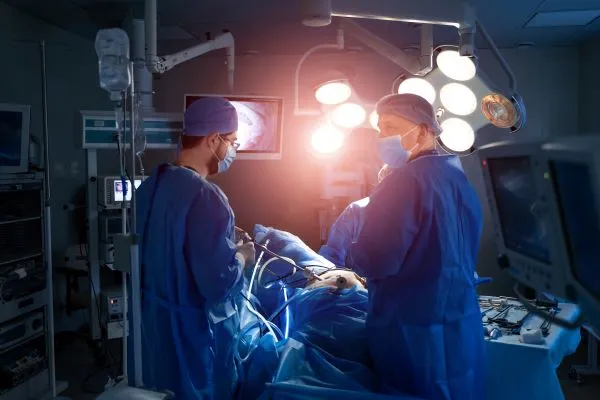Your physician can use 2 different techniques to perform this surgery.
When a patient needs a spinal neurostimulator placement, they must first undergo a trial period before the surgeon determines if they will benefit from a permanent device. After the trial, the surgeon will implant a permanent device if it provides sufficient pain relief for the patient and the payer’s parameters are met.
You will be able to code for all of these services — if you know what to look for.
Check out our primer on coding for neurostimulator placement.
These Patients Need Neurostimulator Placement
Generally, people who need neurostimulator placement are suffering some form of pain with or without neurological dysfunction. Neurostimulators deliver electrical impulses to areas of the nervous system in an effort to stem pain or improve overall function.

While you should check with your payer to see what conditions it covers for neurostimulator placement, this is a list of some potential presentations (including cranial, spinal and peripheral conditions):
Note: This is not an exhaustive list of all the conditions that could necessitate neurostimulator placement, nor is it a list of approved diagnoses for the procedure. Always check with your payer for its policies on neurostimulator placement.
Trial Implant Comes First
For spinal neurostimulators, the payer usually does not allow the surgeon to implant permanent neurostimulator electrodes in the initial procedure. The first time they implant electrodes, it will be temporary. This electrode trial has two purposes:
1. Trial placement is performed first to see if the patient can tolerate the procedure; if they can’t, the surgeon won’t implant a permanent neurostimulator.
2. Trial placement is also performed to confirm that the procedure will relieve the patient’s pain.Typically, if the patient’s pain is reduced by at least 50 percent, the surgeon will look to place permanent electrodes.
Payer alert: Before filing, you should check with your payer about any potential issues with your electrode placement claim. The lists of preconditions and allowable diagnoses can vary by payer.
There are two ways that a surgeon can perform electrode placement. If they place a wire neurostimulator electrode array percutaneously, report 63650 (Percutaneous implantation of neurostimulator electrode array, epidural). Instead of an array, the surgeon might opt for an electrode plate/paddle; these placements are done via laminectomy, which you’d report with 63655(Laminectomy for implantation of neurostimulator electrodes, plate/paddle, epidural).
Report a unit of 63650/63655 for each array the surgeon places, but check with your payer before filing a claim with multiple neurostimulator placements. Payer policy on exactly how to report these encounters will vary. Keep in mind that 63650 has a 10-day global period, whereas 63655 has a 90-day global period.
Surgeon Removes or Replaces Electrodes Post-Trial
After the trial period ends, the patient will return to the surgeon to remove the electrodes and discuss next steps.
When your neurosurgeon removes spinal neurostimulator electrodes in the operating room, you’ll report 63661 (Removal of spinal neurostimulator electrode percutaneous array(s), including fluoroscopy, when performed) or 63662 (Removal of spinal neurostimulator electrode plate/paddle(s) placed via laminotomy or laminectomy, including fluoroscopy, when performed), depending on encounter specifics. If the removal is performed within the global period of the trial placement procedure, append modifier 58 (Staged or related procedure or service by the same physician or other qualified health care professional during the postoperative period) to 63661 or 63662 to show that the surgeon anticipated the procedure.
Then, the surgeon will decide whether the patient should have a permanent neurostimulator implanted.

For permanent implants: If the patient is receiving a permanent neurostimulator, you’ll still report 63661-58 or 63662-58 for the removal of the trial electrodes; however, you’ll also have a few more codes to report.
The patient will need some recovery time to heal after the removal of the previous electrodes. Then, the surgeon will place a new array or plate/paddle. Again, you will report these services using 63650 or 63655 for each array or plate/paddle; also again, you will append modifier 58 to the removal code to show that the surgeon anticipated this procedure.
During the permanent implantation, the surgeon will also implant a long-term pulse generator. Report this service with 63685 (Insertion or replacement of spinal neurostimulator pulse generator or receiver, requiring pocket creation and connection between electrode array and pulse generator or receiver) with modifier 58.
Don’t forget: You can also report a code for the surgeon’s analysis of the neurostimulator results with a code from the 95970 (Electronic analysis of implanted neurostimulator pulse generator/transmitter (eg, contact group[s], interleaving, amplitude, pulse width, frequency [Hz], on/off cycling, burst, magnet mode, dose lockout, patient selectable parameters, responsive neurostimulation, detection algorithms, closed loop parameters, and passive parameters) by physician or other qualified health care professional; with brain, cranial nerve, spinal cord, peripheral nerve, or sacral nerve, neurostimulator pulse generator/transmitter, without programming) through +95984 (Electronic analysis of implanted neurostimulator pulse generator/transmitter (eg, contact group[s], interleaving, amplitude, pulse width, frequency [Hz], on/off cycling, burst, magnet mode, dose lockout, patient selectable parameters, responsive neurostimulation, detection algorithms, closed loop parameters, and passive parameters) by physician or other qualified health care professional; with brain neurostimulator pulse generator/transmitter programming, each additional 15 minutes face-to-face time with physician or other qualified health care professional (List separately in addition to code for primary procedure)) code set.
Chris Boucher, MS, CPC, Senior Development Editor, AAPC
